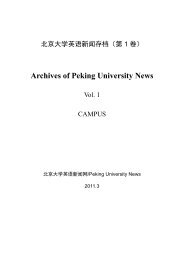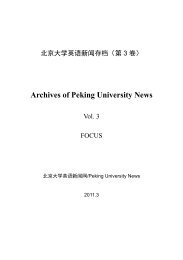Archives of Peking University News - PKU English - 北京大学
Archives of Peking University News - PKU English - 北京大学
Archives of Peking University News - PKU English - 北京大学
You also want an ePaper? Increase the reach of your titles
YUMPU automatically turns print PDFs into web optimized ePapers that Google loves.
<strong>北京大学</strong>英语新闻网/<strong>Peking</strong> <strong>University</strong> <strong>News</strong><br />
Entrance Exam decided to quit and prepared for the next try while only 52% <strong>of</strong> the<br />
students whose score reached score line <strong>of</strong> third level universities in the National<br />
College Entrance Exam decided to enter college. She explained the trends through<br />
new theories about human capital.<br />
Pr<strong>of</strong>. Martin Carnoy analyzed the different characteristics on the high education<br />
expansion in BRIC and their social, political and economic backgrounds. He thinks<br />
that governments <strong>of</strong> China and Russia mainly focused on building up ―the world top<br />
class universities‖ while governments <strong>of</strong> Brazil and India paid attention to the quality<br />
<strong>of</strong> their top universities. The funds <strong>of</strong> public universities in Brazil come mostly from<br />
the public finance. The proportion <strong>of</strong> tuition fee in the funding <strong>of</strong> Chinese universities<br />
increased constantly. Universities in Russia started accepting students at their own<br />
expense. Government <strong>of</strong> India permitted the rapid expansion <strong>of</strong> the private<br />
universities. He pointed out that the purpose <strong>of</strong> this international project is to reveal<br />
the common patterns and different trends in higher education in these countries and<br />
to find the causes in the different trends in BRIC. In BRIC, higher education used to<br />
be supported by public finance, and it seemed to be a type <strong>of</strong> pure public commodity.<br />
However, BRIC are designing financial system for sharing the costs. The expansion<br />
<strong>of</strong> college admission guided by this financial system is different from the expansion<br />
aiming at promoting the productivity and fairness, just as the college expansion in the<br />
US, Japan, and Europe during the late 20‘s century.<br />
Pr<strong>of</strong>. Isak Froumin and Pr<strong>of</strong>. Jandhyala Tilak gave presentations on higher education<br />
<strong>of</strong> engineering in Russia and India respectively. Researchers from CIEFR reported<br />
their research about choosing a university, opportunities for university, and costs and<br />
structure .<strong>of</strong> universities,<br />
Background:<br />
―Higher Education under Global Knowledge Economy‖ is a large international<br />
cooperation project. This project was started and organized by Pr<strong>of</strong>. Martin Carnoy<br />
from Education Institute <strong>of</strong> Stanford <strong>University</strong>. The kernel members <strong>of</strong> this project<br />
are Pr<strong>of</strong>. Isak Froumin from the higher economic institute <strong>of</strong> the National <strong>University</strong><br />
<strong>of</strong> Russia, Jandhyala Tilak from National <strong>University</strong> <strong>of</strong> Educational Planning and<br />
Administration <strong>of</strong> India, and Pr<strong>of</strong>. Wang Rong from CIEFR (China Institute for<br />
Educational Finance Research, <strong>Peking</strong> <strong>University</strong>).<br />
As the four developing countries with the most population in the world, BRIC (Brazil,<br />
Russia, India, and China) may become the most important powers in the world<br />
economy in the next 40 years. There are many factors during the transfer from the<br />
powerful economic entity based on the large population and cheap labor force or<br />
natural resources to the developed economy based on the knowledge industry and<br />
service industry. One <strong>of</strong> these factors is the development <strong>of</strong> the national education<br />
system, especially higher education system. The purpose <strong>of</strong> this project is to find the<br />
112




